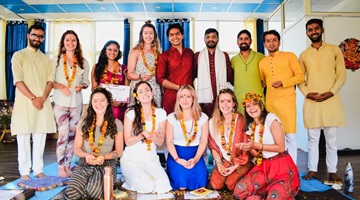Why People in "Blue Zones" Live Longer Than the Rest of the World

“Blue Zones” are unique regions across the world where people consistently enjoy longer, healthier lives, with significantly lower rates of chronic disease. These longevity hotspots share common lifestyle factors such as simple, plant-based diets, natural daily movement, purposeful living, and strong community bonds. Blue Zones have been identified in Italy, Greece, Japan, Costa Rica, and even within the United States.
While genetics play a role in how long we live, modern research shows that lifestyle choices have a far greater impact. In these regions, healthy aging isn’t an exception—it’s a natural outcome of how people eat, move, connect, and live each day.
This article explores the key habits and cultural patterns that define Blue Zone living, helping us understand why people there not only live longer, but also enjoy higher-quality, disease-free years.
What are Blue Zones?
A “Blue Zone” is a term used to describe specific geographic regions around the world where people live significantly longer and healthier lives than the global average. The concept was introduced by author and explorer Dan Buettner, who studied these remarkable communities to understand the secrets behind their exceptional longevity. The name “Blue Zones” comes from the blue circles Buettner and his team drew on the map while identifying these regions.
In his book “The Blue Zones,” Buettner highlights five well-established Blue Zones:
-
Icaria, Greece:
A remote Greek island where residents follow a traditional Mediterranean diet rich in olive oil, red wine, and homegrown vegetables. The lifestyle is slow-paced, community-centered, and deeply connected to nature.
-
Ogliastra, Sardinia (Italy):
This mountainous region of Sardinia is home to some of the world’s oldest men. Many work on farms throughout their lives, walk long distances daily, and enjoy antioxidant-rich local red wine.
-
Okinawa, Japan:
Known for having the highest population of the world’s oldest women, Okinawans eat nutrient-dense, mostly plant-based meals, including plenty of soy-based foods. Gentle movement practices like tai chi are part of their daily routine.
-
Nicoya Peninsula, Costa Rica:
Here, seniors often remain active well into old age. Their diet centers around beans, corn tortillas, and fresh produce. They also maintain a strong “plan de vida”—a deep sense of purpose that keeps them mentally and emotionally resilient.
-
Loma Linda, California (USA):
Home to a large community of Seventh-day Adventists, who follow a strict vegetarian diet, strong family values, and faith-based living. Their close-knit community and healthy habits contribute to unusually long lifespans.
While Buettner’s book focuses on these five regions, researchers believe there may be other locations worldwide with similar longevity patterns. Studies show that Blue Zones have exceptionally high numbers of nonagenarians and centenarians—people who live beyond 90 and 100 years. Surprisingly, genetics account for only 20–30% of lifespan, meaning lifestyle and environment play a much larger role.
Below are some of the shared dietary and lifestyle habits that contribute to the remarkable longevity seen in Blue Zones.
People who live in a Blue Zone eat a diet full of whole plant foods
People in Blue Zones Eat Diets Rich in Whole, Plant-Based Foods
A defining feature of Blue Zone communities is their predominantly plant-based diet—approximately 95% of what they eat comes from whole plant foods. While most residents are not strict vegetarians, they consume meat sparingly, often no more than five times a month.
Research supports this pattern. Large studies—including one involving over half a million participants—show that minimizing red and processed meat can significantly reduce the risk of heart disease, cancer, and other major causes of death.
Instead of meat-heavy meals, Blue Zone diets emphasize:
-
Vegetables:
Rich in fiber, vitamins, and minerals, vegetables form the foundation of daily meals. Eating more than five servings of fruits and vegetables per day has been shown to lower the risk of heart disease, cancer, and overall mortality.
-
Legumes:
Beans, lentils, peas, and chickpeas are essential staples. Packed with protein and fiber, legumes are strongly linked with reduced mortality and improved long-term health.
-
Whole grains:
A major source of sustained energy and digestive health, whole grains help reduce blood pressure and are associated with a lower risk of colorectal cancer and fatal heart disease.
By prioritizing nutrient-dense plant foods and limiting animal products, people in Blue Zones naturally support longevity, vitality, and lifelong well-being.
They follow the 80% rule
Another powerful habit shared across Blue Zone communities is mindful eating—particularly through reduced calorie intake and occasional fasting.
Dietary Restriction and Longevity
Long-term calorie restriction has been linked to extended lifespan in several studies. A notable 25-year study on monkeys found that consuming 30% fewer calories significantly increased their longevity. This suggests that part of the extraordinary life expectancy in Blue Zones may stem from naturally lower calorie consumption.
Research on Okinawans, for example, shows that before the 1960s they regularly lived in a state of mild calorie deficit—eating slightly less than their daily needs. This lifestyle pattern is believed to contribute to their exceptional health and long lifespan.
The 80% Rule: “Hara Hachi Bu”
Okinawans famously practice hara hachi bu, a Confucian-inspired principle that encourages stopping a meal when you're about 80% full. Instead of eating until they feel completely satisfied, they intentionally pause before reaching fullness.
This practice helps prevent overeating, which reduces the risks of weight gain and chronic diseases. It also aligns with research showing that eating slowly increases satiety. Since the hormones that signal fullness typically peak around 20 minutes after a meal begins, slowing down allows the body time to recognize when it has had enough.
By eating mindfully and stopping before fullness, people naturally consume fewer calories while staying satisfied for longer.
Smaller Evening Meals
Another hallmark of Blue Zone eating patterns is consuming the smallest meal in the late afternoon or early evening and then avoiding food for the rest of the day. This gentle form of intermittent fasting helps regulate digestion and supports metabolic health.
They Consume Alcohol in Moderation
Moderate alcohol consumption is another common lifestyle feature in several Blue Zone regions. While research on its health effects remains mixed, many long-living communities do enjoy small amounts of alcohol—often as part of a social, relaxed lifestyle.
Some studies suggest that drinking one to two alcoholic beverages per day may reduce overall mortality, particularly from heart disease. However, more recent research indicates that when other lifestyle factors are taken into account, moderate drinking may not independently lower the risk of death. In other words, the benefits may be tied more to overall healthy living than alcohol itself.
Why Red Wine Stands Out
If any form of alcohol has potential benefits, red wine appears to be the most promising. It contains antioxidant-rich compounds derived from grapes, which help protect cells from DNA damage—a process closely linked to aging.
In Blue Zones like Icaria (Greece) and Sardinia (Italy), it is common for people to drink one to two glasses of red wine daily, often with meals and in the company of others. Sardinia’s famous Cannonau wine, made from Grenache grapes, contains exceptionally high levels of antioxidants compared to many other wines.
Several studies have linked moderate red wine consumption to:
-
Lower blood pressure
-
Reduced blood sugar
-
Higher levels of “good” cholesterol (HDL)
-
Improved sleep quality
These benefits were observed in individuals who drank about one 5-ounce (150-ml) glass of wine per day for six months to two years.
Moderation Is Key
It's crucial to note that potential benefits apply strictly to moderate consumption. Every study also shows the same pattern: as alcohol intake increases, so does the risk of mortality. Heavy drinking cancels out any positive effects and can significantly damage health.
Exercise Is Naturally Built Into Daily Life
Beyond diet, daily movement plays a crucial role in the longevity seen in Blue Zones. Instead of structured workouts, physical activity is woven seamlessly into everyday routines—gardening, walking, cooking, tending to animals, and performing household chores all contribute to constant low-intensity movement throughout the day.
One study focusing on men in the Sardinian Blue Zone found that certain lifestyle factors—such as caring for farm animals, navigating steep mountain terrain, and walking long distances to work—were strongly associated with longer lifespans. Another large study of more than 13,000 men showed that the amount they walked and the number of flights of stairs they climbed each day directly predicted how long they lived.
Scientific evidence consistently supports the idea that regular physical activity reduces the risk of cancer, heart disease, and premature death.
According to the Physical Activity Guidelines for Americans, adults should aim for:
-
150 minutes of moderate-intensity aerobic activity per week, or
-
75 minutes of vigorous-intensity activity per week.
A massive study involving over 600,000 participants found that those who met these activity guidelines had a 20% lower mortality risk compared to individuals who did no exercise at all. Another large-scale study further revealed that vigorous physical activity was associated with even lower mortality rates than moderate-intensity exercise.
In Blue Zones, movement isn’t a chore—it’s simply part of everyday life. This consistent, natural activity may be one of the strongest contributors to their remarkable longevity.
They Get Enough Sleep
Along with nutrition and movement, quality sleep is another essential pillar of longevity in Blue Zone communities. People living in these regions prioritize rest, getting sufficient sleep at night and often enjoying short daytime naps.
Multiple studies show that both too little and too much sleep are linked to a significantly higher risk of death, particularly from heart disease and stroke. A comprehensive analysis of 35 studies found that seven hours of sleep per night is the optimal amount for long-term health. Sleeping far less—or far more—was associated with increased mortality.
Unlike many modern lifestyles dictated by strict schedules, people in Blue Zones tend to follow their body’s natural rhythms. They go to bed, wake up, and start their day according to how they feel rather than the numbers on a clock.
Daytime naps, especially common in places like Icaria and Sardinia, also contribute to their overall well-being. Research shows that short naps—often called “siestas” in Mediterranean cultures—are not harmful and may even protect against heart disease and early death.
However, nap duration matters. Short naps of 30 minutes or less appear to be beneficial, while longer naps may actually increase the risk of heart disease and mortality.
In Blue Zones, rest is not seen as a luxury—it is a natural, essential part of daily life that supports long-term health and vitality.
Other Traits and Habits Associated with Longevity
Beyond diet, movement, and rest, several social and lifestyle factors consistently appear in Blue Zone communities—and they may play a significant role in their exceptional longevity. These include:
-
Being religious or spiritual:
Many Blue Zone populations are deeply rooted in faith-based or spiritual traditions. Studies suggest that being part of a religious community is linked to a lower risk of death, possibly because it provides strong social support, a sense of belonging, and reduced rates of depression.
-
Having a clear life purpose:
Residents of Blue Zones often live with a strong sense of purpose. Okinawans call it ikigai, while people in Nicoya refer to it as plan de vida. This sense of direction and meaning is associated with improved psychological well-being and a lower risk of mortality.
-
Multiple generations living together:
In many Blue Zone societies, grandparents, parents, and children share the same home. Research shows that older adults who care for their grandchildren tend to live longer than those who do not. Intergenerational living fosters emotional support, security, and a stronger sense of community.
-
Healthy social networks:
Social circles strongly influence health. In Okinawa, these supportive groups are known as moai. Studies reveal that if your friends practice healthy habits, you are more likely to do the same. Conversely, if your close social network struggles with issues like obesity, the likelihood of adopting similar habits increases—often due to social normalization.
These interconnected lifestyle elements create a powerful foundation for long-term well-being, showing that longevity is not just about how we eat and move—but also how we connect, contribute, and find meaning in everyday life.
The Bottom Line
Blue Zones are home to some of the world’s longest-living and healthiest people. Although each region has its own unique culture and traditions, they share several powerful lifestyle patterns: predominantly plant-based diets, natural daily movement, moderate alcohol consumption, restful sleep, and strong spiritual, family, and social connections.
Each of these habits has been linked to better health and increased longevity. By integrating even a few of these practices into your own life, you can support your well-being, boost your vitality, and potentially extend your lifespan.
What's Your Reaction?


























